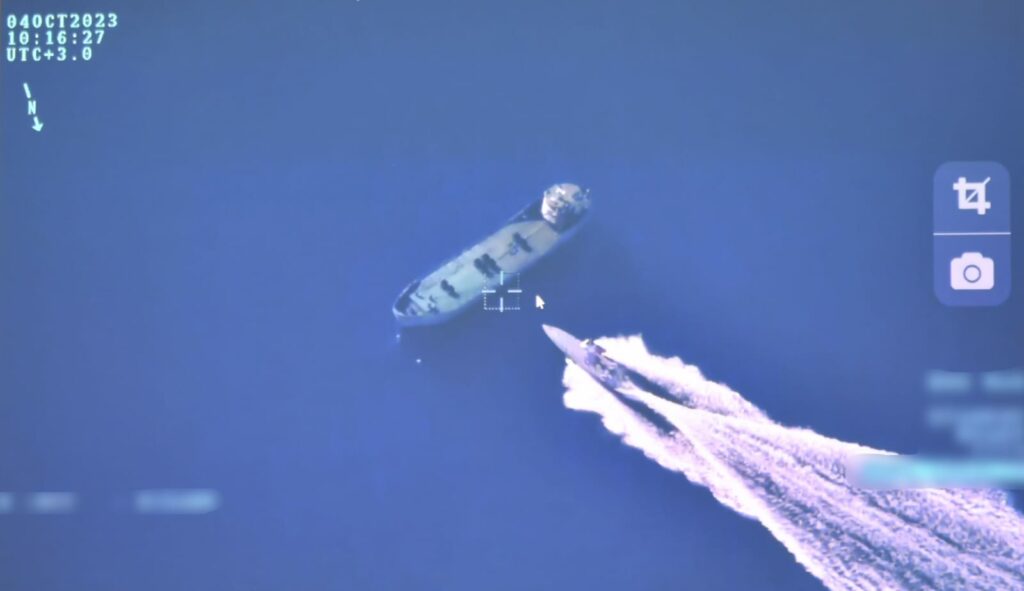Fatih Yurtsever*
Russia’s invasion of Ukraine on Feb. 24, 2022 transformed the geopolitical landscape and heralded a potential shift in naval warfare. This shift was evident in Ukraine’s effective use of Kamikaze unmanned surface vehicles (USVs) against Russian warships and the Sevastopol base. The Turkish Navy, which closely monitors the naval dimensions of the Russia-Ukraine conflict in the Black Sea, seeks to adapt and improve its capabilities based on the lessons learned. A major focus is the use of USVs operating in swarm formations autonomously guided by artificial intelligence algorithms. When synchronized with unmanned combat aerial vehicles (UCAVs) within a unified network domain, this tactic promises to be a game-changer, a capability many navies aspire to acquire.
On Oct. 9, 2023 the Turkish Ministry of Defense announced that for the first time in the world, a swarm of USVs and a UCAV had successfully attacked a ship target. The Albatros kamikaze USV, developed by Turkish defense company ASELSAN, was test-fired in the eastern Mediterranean off the coast of Mersin on Oct. 8. A swarm of eight Albatros USVs attacked the target ship, and one of them, carrying a Roketsan-manufactured warhead, successfully hit and detonated, sinking the 22-meter target ship in minutes. A Bayraktar TB2 UCAV from the Turkish Naval Forces Command also participated in the test, directing the USVs to the target. This successful test demonstrates Turkey’s capability to carry out USV swarm kamikaze attacks.
In the test footage shared by the Presidency of Defense Industry (SSB), a Bayraktar TB2 UCAV of the Naval Forces detected the target ship at 08:30 on the morning of Oct. 8. At 09:30, the control station assigned a swarm of Albatros USVs to destroy the detected target. In the images three USVs in a swarm were moving towards the target. The vessels on the starboard and port sides left the formation, and the USV in the middle moved directly towards the target, hitting and sinking it.
For the test firing to be considered a UCAV-USV joint operation, the following conditions must be met:
- The TB2 Bayraktar and Albatros USVs must be on the same data link.
- Within the scope of network-based operation, the surface track detected by the TB-2 without any user intervention must be transmitted to the Albatros USVs through the data link.
Based on the available information, it is not clear whether these conditions were met. The images show that the operator using the TB-2 informed the shore station controlling the Albatros USVs via voice reporting that the surface target had been detected. The control station then directed the Albatros USVs to the target to destroy it. This suggests that the TB-2 and Albatros USVs may not have been on the same data link and that the operator may have manually directed the Albatros USVs to the target.
To be considered a swarm attack, the USVs need to establish a link among themselves and autonomously decide from which direction, how and how many USVs will engage the target in line with artificial intelligence-based attack algorithms. It is unclear from the images whether the USVs moved autonomously or were directed to the target by the operator. However, based on Aselsan’s previous experiments with Albatros USVs, the vessels can move autonomously to the target with the guidance of the artificial intelligence algorithm and decide on the engagement.
Using a TB2 for target detection alone does not make this operation a UCAV-USV joint operation. The target detected by the TB-2 can also be detected by a patrol boat, helicopter or maritime patrol aircraft, and the location of the target can be reported to the control station. The most important point here is that UCAVs and USVs must automatically share the targets they detect within the same network architecture. Then, by using artificial intelligence-based mission algorithms, USVs can simultaneously destroy the target in a swarm from different directions in a way that saturates the target’s self-defense systems.
However, the defense industry in Turkey as an apparatus for flattering the public and mobilizing nationalist sentiments makes it difficult to objectively evaluate the effectiveness and competence of the weapons systems developed by the Turkish defense industry. For example Turkish President Recep Tayyip Erdoğan and senior executives of defense industry contractors, especially Selçuk Bayraktar, Erdoğan’s son-in-law and chairman of the board of directors of Baykar, the company that manufactures the TB2 drones, claim that UCAVs are produced entirely domestically and nationally. However, German defense electronics manufacturer Hensoldt told Reuters that it has equipped the Bayraktar TB2 with the ARGOS II optical sensor since 2020. Hensoldt said it had also supplied the sensor to two other Turkish drone manufacturers, Turkish Aerospace Industries (TAI) and the Vestel company. The quantities and exact delivery dates of the sensors are confidential and cannot be shared, Hensoldt said. “Without such sensors, drones as we know them would not work,” said Kelsey Gallagher, a researcher at Project Ploughshares, a Canadian peace research institute.
As the Russia-Ukraine war has demonstrated, unmanned and autonomous systems will cause major changes, especially in naval warfare. Turkey must transform its defense industry from a domestic political tool to ensure its national security. While Turkey has made progress in the defense industry in the last 10 years, the capabilities gained are insufficient to make it a top defense industry player. Turkey is moving forward on the right roadmap for using UCAVs and USVs in joint operations. However, it still has some distance to cover and capabilities to acquire.
* Fatih Yurtsever is a former naval officer in the Turkish Armed Forces. He is using a pseudonym out of security concerns.

